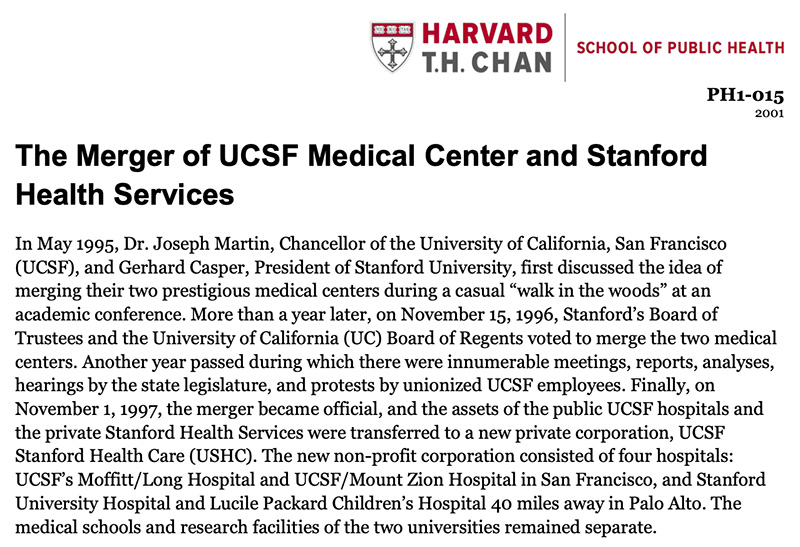
In the fast-paced world of healthcare, mergers and acquisitions have become a common strategy for organizations seeking to enhance their competitiveness, navigate financial challenges, and improve patient care. However, not all mergers result in success stories, as the case of the UCSF-Stanford merger demonstrates. We had dissected and discussed an interesting case study – the merger of UCSF Medical Centre and Stanford Health Service during my Senior Management Programme in Healthcare Management with IIM Kozhikode. Perhaps the UCSF-Stanford merger is one of the most widely discussed case studies. Here is my analysis article that delves into the complexities of this merger, its unravelling, and the lessons it offers for the healthcare industry.

A Bold Vision Meets Financial Reality
In 1997, two prestigious institutions, the University of California, San Francisco (UCSF), and Stanford University, embarked on an ambitious journey. They decided to merge their medical centres to form UCSF Stanford Health Care, a ground-breaking venture aimed at weathering the turbulent financial storm brought on by the rise of managed care in the United States.
The primary rationale behind the merger was straightforward: by pooling resources, increasing bargaining power, and streamlining operations, the combined entity was projected to save a staggering $256 million by the turn of the century. However, as often happens with ambitious endeavours, reality had a different story to tell.
The Unforeseen Challenges
- Cultural Divide: Perhaps one of the most significant challenges faced by UCSF Stanford Health Care was the inability to bridge the cultural gap between the two institutions. Despite the merger, most professors and staff continued to identify strongly with their respective home campuses. The shared culture that was envisioned never fully materialized.
- Integration Complexity: The complexity of integrating two distinct institutions proved far more challenging than anticipated. A key milestone was the consolidation of clinical services, which failed to materialize by the September 1, 1999, deadline. Except for paediatrics, physicians did not unite their practices, share risks, or pool revenues as envisaged. This lack of integration hindered the achievement of anticipated cost savings.
- Financial Pressures: The merger took place against a backdrop of increasing financial pressures on healthcare organizations. Managed care companies continued to cut payments to hospitals, while federal and state governments reduced reimbursements. The 1997 U.S. Balanced Budget Act alone resulted in a $10 million drop in Medicare pay-outs to the hospitals. Concurrently, the state’s Medi-Cal program slashed payments, leaving academic medical centres with a growing burden of providing uncompensated care.
- Unexpected Costs: The financial challenges were exacerbated by unexpected costs associated with the merger itself. For instance, integrating computer systems, initially projected to cost $25 million, ballooned to a staggering $126 million, five times the original estimate. Payroll costs also spiralled, with an additional 1,000 employees hired post-merger, far surpassing the projected 200 new hires.
- Mount Zion Hospital: A significant financial shock came from UCSF’s Mount Zion Hospital, which incurred approximately three-quarters of the $86 million in losses during the last fiscal year. Mount Zion, renowned for serving San Francisco’s low-income residents, was the subject of vocal political support but ultimately closed its doors in November.
The Costly Divorce
As the challenges mounted, it became increasingly evident that the grand vision of a united healthcare powerhouse was unravelling. In October 1999, Stanford’s President, Gerhard Casper, reluctantly made the call for the dissolution of the merger. It was a decision that highlighted the gravity of the situation.
The financial consequences of the merger’s unravelling were significant. Each institution was to reclaim the resources it had contributed (Stanford with assets valued at $458 million and UCSF with $415 million). However, the remaining losses were to be shared equally. By November, a seven-page memo outlined the unresolved issues, and officials aimed to complete the separation by March 1.
Lessons Learned
The UCSF-Stanford merger and its subsequent dissolution offer several crucial lessons for the healthcare industry:
- Culture Matters: The failure to foster a shared culture can hinder the success of any merger. Healthcare organizations must invest in initiatives that promote a sense of unity and common purpose among staff and professionals.
- Integration Complexity: Integrating two distinct institutions is a formidable task. It requires meticulous planning, a clear roadmap, and a commitment to achieving synergy in clinical practices and operations.
- Financial Realities: Healthcare organizations must be acutely aware of the evolving financial landscape. Economic pressures, changes in reimbursement policies, and shifts in the healthcare market can have a profound impact on the success of a merger.
- Cost Management: Anticipating and managing the costs associated with a merger is essential. Unforeseen expenses can strain the financial resources of even the most prominent institutions.
- Transparent Evaluation: Regular evaluations and audits can help healthcare organizations identify financial challenges and areas where the merger may fall short of expectations. Transparency in assessing the merger’s impact is crucial.
Path Forward
While the unravelling of the UCSF-Stanford merger was undoubtedly a challenging chapter in both institutions’ histories, it is important to consider the long-term outcomes. Despite facing initial setbacks, Stanford is bounced back and prospered. In the fiscal year 2023-2023, Stanford operates as an $8.2 billion enterprise. This amount reflects the university’s consolidated operational budget, which encompasses the combined total of all yearly operating and restricted budgets dedicated to supporting teaching, scholarship, and research. This includes the budgets for all academic schools, administrative sectors, and the SLAC National Accelerator Laboratory. However, it’s important to note that this figure does not encompass the $0.6 billion allocated for the capital budget and does not cover the budgets of Stanford Health Care and Lucile Packard Children’s Hospital.
UCSF, on the other hand, faced an extended period of financial challenges. The cost of the separation, estimated at $79 million, is a substantial figure, albeit a necessary expense. However, it has subsequently performed well. For the year 2023-24, UCSF Medical Center has been ranked as one of the top hospitals in the nation. In its latest rankings, U.S. News & World Report places UCSF Health’s adult care among the top 10 nationally in seven specialties. Additionally, it is recognized as the best in the Western United States for both neurology/neurosurgery and rheumatology.
As the healthcare industry continues to evolve and consolidate, the UCSF-Stanford merger serves as a stark reminder of the intricate dynamics at play in healthcare partnerships. It underscores the importance of clear vision, meticulous planning, and adaptability in navigating the complexities of mergers in the ever-changing landscape of healthcare delivery.
In the end, the UCSF-Stanford merger and its subsequent dissolution offer a valuable case study for the healthcare industry. It highlights the critical need for cultural alignment, integration, financial awareness, cost management, and transparent evaluation in the process of healthcare consolidation. While the path forward may be challenging, the lessons learned from this experience will undoubtedly shape the future of healthcare partnerships and mergers.
The successful merger of companies hinges significantly on the compatibility and integration of their organizational cultures. Recognizing and addressing the distinct subcultures within each entity is crucial, as these influence employee responses to the merger. Learning from case studies like UCSF-Stanford merger underscores the importance of managing cultural change, maintaining a balance between preserving positive cultural elements and encouraging their evolution. Effective communication and inclusive practices are essential to ensure employees from both organizations feel valued, fostering a unified culture in the merged entity. Ultimately, strategic cultural integration is key to the merger’s success, enabling adaptability and long-term sustainability.
Prahlada N. B
28 November 2023
Chitradurga.

















Prahlada Sir 💐
Any merger should entail
merger of minds & hearts , both, to have a synergistic effect.
There shouldn’t be clash of cultures.
Consultations & discussion should involve ‘all’, in the hierarchy from both parties , starting from bottom, like in a Pyramid.
It shouldn’t be confined to ‘Heads’ only.
Individual opinion from grassroots level , should be accessed & assessed , over a period of time , to find out the feasibility of the merger & its sustainability & longevity thereafter.
Ofcourse, financial implications also have to be considered.
In this context, the merger of UCSF Medical Center & Stanford Health Services , the two prestigious medical centres …..didn’t last long.
The merger venture’s biggest downfall may have been that it never managed to bind the two institutions together with a common culture.
Reply